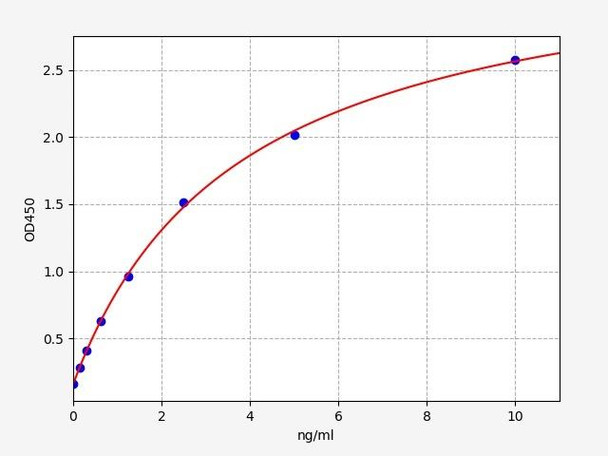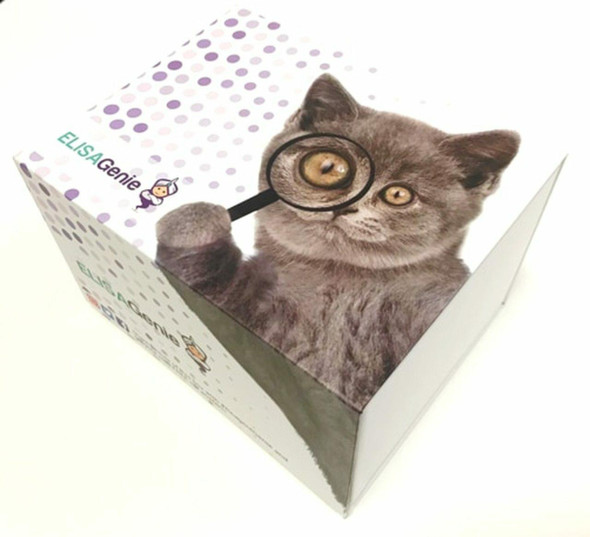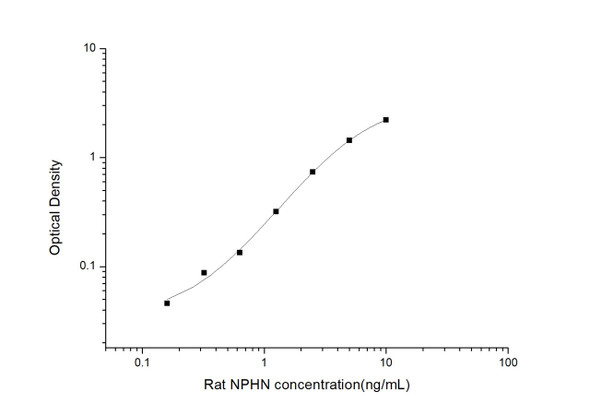Rat Nephrin ELISA Kit
- SKU:
- RTFI00994
- Product Type:
- ELISA Kit
- Size:
- 96 Assays
- Uniprot:
- Q9R044
- Sensitivity:
- 0.094ng/ml
- Range:
- 0.156-10ng/ml
- ELISA Type:
- Sandwich
- Synonyms:
- NPHN, CNF, NPHS1, CNF, nephrosis 1, congenital, Finnish type, nephrin, NPHNCNF, NPHS1, Renal glomerulus-specific cell adhesion receptor
- Reactivity:
- Rat
- Research Area:
- Cell Biology
Description
Rat Nephrin ELISA Kit
The Rat Nephrin ELISA Kit is specifically designed for the precise measurement of nephrin levels in rat serum, plasma, and cell culture supernatants. This kit offers exceptional sensitivity and specificity, guaranteeing accurate and consistent results for a variety of research purposes.Nephrin is a key protein found in the kidney's filtration barrier, playing a vital role in maintaining kidney function and preventing protein leakage into the urine. Changes in nephrin levels have been linked to various kidney diseases, including diabetic nephropathy and glomerulonephritis, making it an important marker for understanding and treating these conditions.
With its advanced technology and reliable performance, the Rat Nephrin ELISA Kit is an invaluable tool for researchers studying renal function, kidney diseases, and potential therapeutic interventions. Trust in this kit to deliver precise and dependable results for your experimental needs.
| Product Name: | Rat NPHN (Nephrin) ELISA Kit |
| Product Code: | RTFI00994 |
| Size: | 96 Assays |
| Target: | Rat NPHN |
| Alias: | NPHN, CNF, NPHS1, CNF, nephrosis 1, congenital, Finnish type, nephrin, NPHNCNF, NPHS1, Renal glomerulus-specific cell adhesion receptor |
| Reactivity: | Rat |
| Detection Method: | Sandwich ELISA, Double Antibody |
| Sensitivity: | 0.094ng/ml |
| Range: | 0.156-10ng/ml |
| Storage: | 4°C for 6 months |
| Note: | For Research Use Only |
| Recovery: | Matrices listed below were spiked with certain level of Rat NPHN and the recovery rates were calculated by comparing the measured value to the expected amount of Rat NPHN in samples. | ||||||||||||||||
| |||||||||||||||||
| Linearity: | The linearity of the kit was assayed by testing samples spiked with appropriate concentration of Rat NPHN and their serial dilutions. The results were demonstrated by the percentage of calculated concentration to the expected. | ||||||||||||||||
| |||||||||||||||||
| Intra-Assay: | CV <8% | ||||||||||||||||
| Inter-Assay: | CV <10% |
| Uniprot: | Q9R044 |
| UniProt Protein Function: | NPHS1: Seems to play a role in the development or function of the kidney glomerular filtration barrier. Regulates glomerular vascular permeability. May anchor the podocyte slit diaphragm to the actin cytoskeleton. Plays a role in skeletal muscle formation through regulation of myoblast fusion. Interacts with CD2AP (via C-terminal domain). Interacts with MAGI1 (via PDZ 2 and 3 domains) forming a tripartite complex with IGSF5/JAM4. Interacts with DDN; the interaction is direct. Self-associates (via the Ig-like domains). Also interacts (via the Ig-like domains) with KIRREL/NEPH1 and KIRREL2; the interaction with KIRREL is dependent on KIRREL glycosylation. Forms a complex with ACTN4, CASK, IQGAP1, MAGI2, SPTAN1 and SPTBN1. Interacts with NPHS2. Specifically expressed in podocytes of kidney glomeruli. Belongs to the immunoglobulin superfamily. 2 isoforms of the human protein are produced by alternative splicing. |
| UniProt Protein Details: | Protein type:Cell adhesion; Immunoglobulin superfamily; Membrane protein, integral Chromosomal Location of Human Ortholog: 1q21 Cellular Component: cell projection; lipid raft; membrane; plasma membrane; protein complex Molecular Function:alpha-actinin binding; myosin binding; protein binding; protein domain specific binding; spectrin binding Biological Process: cell adhesion; glomerular basement membrane development; glomerular filtration; JNK cascade; MAPKKK cascade; myoblast fusion; positive regulation of actin filament polymerization; skeletal muscle development |
| NCBI Summary: | renal protein localized specifically to glomerular capillary walls; may contribute to the development of proteinuria in renal disease [RGD, Feb 2006] |
| UniProt Code: | Q9R044 |
| NCBI GenInfo Identifier: | 12018318 |
| NCBI Gene ID: | 64563 |
| NCBI Accession: | NP_072150.1 |
| UniProt Secondary Accession: | Q9R044,Q9JIX2, Q9QXX7, |
| UniProt Related Accession: | Q9R044 |
| Molecular Weight: | 126,646 Da |
| NCBI Full Name: | nephrin |
| NCBI Synonym Full Names: | NPHS1 nephrin |
| NCBI Official Symbol: | Nphs1 |
| NCBI Protein Information: | nephrin |
| UniProt Protein Name: | Nephrin |
| UniProt Synonym Protein Names: | Renal glomerulus-specific cell adhesion receptor |
| UniProt Gene Name: | Nphs1 |
| Step | Procedure |
| 1. | Set standard, test sample and control (zero) wells on the pre-coated plate respectively, and then, record their positions. It is recommended to measure each standard and sample in duplicate. Wash plate 2 times before adding standard, sample and control (zero) wells! |
| 2. | Aliquot 0.1ml standard solutions into the standard wells. |
| 3. | Add 0.1 ml of Sample / Standard dilution buffer into the control (zero) well. |
| 4. | Add 0.1 ml of properly diluted sample ( Human serum, plasma, tissue homogenates and other biological fluids.) into test sample wells. |
| 5. | Seal the plate with a cover and incubate at 37°C for 90 min. |
| 6. | Remove the cover and discard the plate content, clap the plate on the absorbent filter papers or other absorbent material. Do NOT let the wells completely dry at any time. Wash plate X2. |
| 7. | Add 0.1 ml of Biotin- detection antibody working solution into the above wells (standard, test sample & zero wells). Add the solution at the bottom of each well without touching the side wall. |
| 8. | Seal the plate with a cover and incubate at 37°C for 60 min. |
| 9. | Remove the cover, and wash plate 3 times with Wash buffer. Let wash buffer rest in wells for 1 min between each wash. |
| 10. | Add 0.1 ml of SABC working solution into each well, cover the plate and incubate at 37°C for 30 min. |
| 11. | Remove the cover and wash plate 5 times with Wash buffer, and each time let the wash buffer stay in the wells for 1-2 min. |
| 12. | Add 90 µL of TMB substrate into each well, cover the plate and incubate at 37°C in dark within 10-20 min. (Note: This incubation time is for reference use only, the optimal time should be determined by end user.) And the shades of blue can be seen in the first 3-4 wells (with most concentrated standard solutions), the other wells show no obvious color. |
| 13. | Add 50 µL of Stop solution into each well and mix thoroughly. The color changes into yellow immediately. |
| 14. | Read the O.D. absorbance at 450 nm in a microplate reader immediately after adding the stop solution. |
When carrying out an ELISA assay it is important to prepare your samples in order to achieve the best possible results. Below we have a list of procedures for the preparation of samples for different sample types.
| Sample Type | Protocol |
| Serum: | If using serum separator tubes, allow samples to clot for 30 minutes at room temperature. Centrifuge for 10 minutes at 1,000x g. Collect the serum fraction and assay promptly or aliquot and store the samples at -80°C. Avoid multiple freeze-thaw cycles. If serum separator tubes are not being used, allow samples to clotovernight at 2-8°C. Centrifuge for 10 minutes at 1,000x g. Removeserum and assay promptly or aliquot and store the samples at-80°C. Avoid multiple freeze-thaw cycles. |
| Plasma: | Collect plasma using EDTA or heparin as an anti-coagulant. Centrifuge samples at 4°C for 15 mins at 1000 × g within 30 mins of collection. Collect the plasma fraction and assay promptly or aliquot and store the samples at -80°C. Avoid multiple freeze-thaw cycles.Note: Over haemolysed samples are not suitable for use with this kit. |
| Urine & Cerebrospinal Fluid: | Collect the urine (mid-stream) in a sterile container, centrifuge for 20 mins at 2000-3000 rpm. Remove supernatant and assay immediately. If any precipitation is detected, repeat the centrifugation step. A similar protocol can be used for cerebrospinal fluid. |
| Cell Culture Supernatant: | Collect the cell culture media by pipette, followed by centrifugation at 4°C for 20 mins at 1500 rpm. Collect the clear supernatant and assay immediately. |
| Cell Lysates: | Solubilize cells in lysis buffer and allow to sit on ice for 30 minutes. Centrifuge tubes at 14,000 x g for 5 minutes to remove insoluble material. Aliquot the supernatant into a new tube and discard the remaining whole cell extract. Quantify total protein concentration using a total protein assay. Assay immediately or aliquot and store at ≤ -20°C. |
| Tissue Homogenates: | The preparation of tissue homogenates will vary depending upon tissue type. Rinse tissue with 1X PBS to remove excess blood & homogenizein 20ml of 1X PBS (including protease inhibitors) and store overnight at ≤ -20°C. Two freeze-thaw cycles are required to break the cell membranes. To further disrupt the cell membranes you can sonicate the samples. Centrifuge homogenates for 5 mins at 5000xg. Remove the supernatant and assay immediately or aliquot and store at -20°C or-80°C. |
| Tissue Lysates: | Rinse tissue with PBS, cut into 1-2 mm pieces, and homogenize with a tissue homogenizer in PBS. Add an equal volume of RIPA buffer containing protease inhibitors and lyse tissues at room temperature for 30 minutes with gentle agitation. Centrifuge to remove debris. Quantify total protein concentration using a total protein assay. Assay immediately or aliquot and store at ≤ -20 °C. |
| Breast Milk: | Collect milk samples and centrifuge at 10,000 x g for 60 min at 4°C. Aliquot the supernatant and assay. For long term use, store samples at -80°C. Minimize freeze/thaw cycles. |








